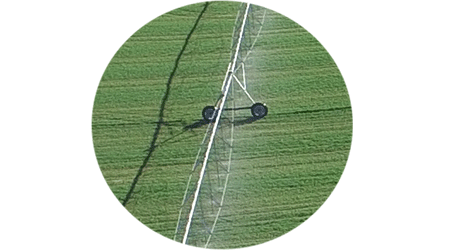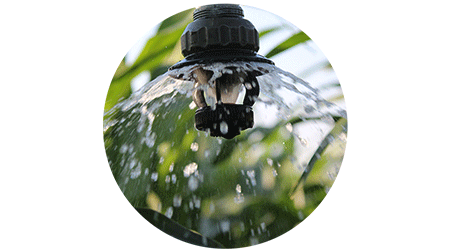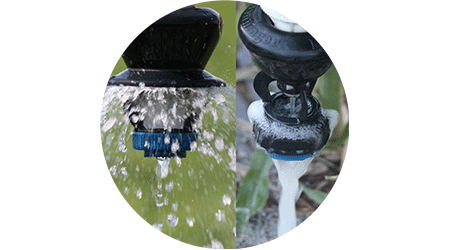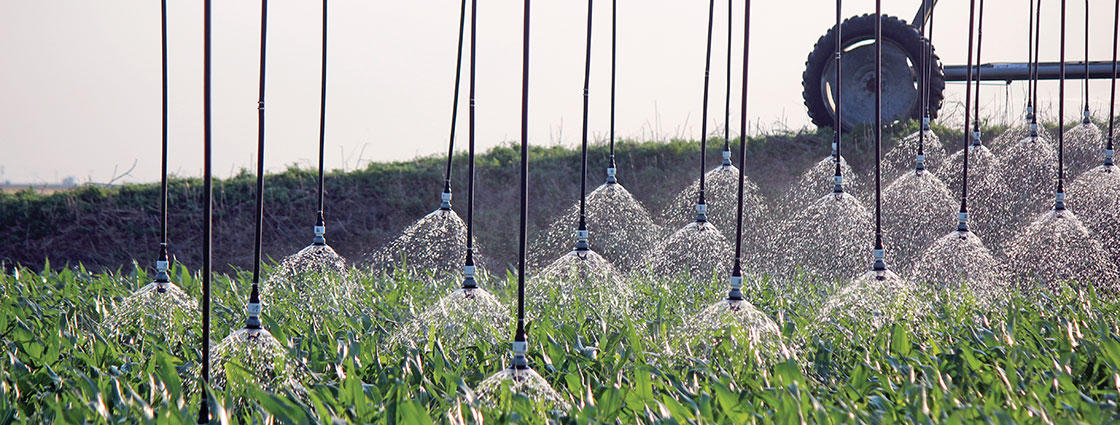
What is LEPA?
LEPA (Low Energy Precision Application) irrigation is a water-efficient irrigation practice that uses low-pressure LEPA bubble applicators. Researchers have found that with LEPA sprinklers, at least 20% more water reaches the soil surface compared to conventional spray heads.
LEPA Bubblers sprinklers gently deposit water from a height of 8 to 18 inches (20 to 46 cm) above the ground, so water reaches the soil quickly. This greatly reduces the chance for wind or evaporation loss due to high temperatures or strong winds. These sprinklers also operate at low pressures ranging from 6 to 20 psi (0.41 to 1.38 bar), which allows growers to take advantage of energy savings.
In early LEPA installations, applicators were mounted far apart to irrigate every other furrow. The Close Spacing method uses the same low-energy bubbler heads but requires them to be installed 30 to 40 inches (0.75 to 1 m) apart to distribute water over most of the soil surface. As a result, LEPA Close Spacing technology ensures 95 to 98% of the water pumped gets to the crop’s root zone.
BENEFITS
- More Uniform Root Zone Coverage
Bubble application prevents wind-drift and evaporation losses due to high temperatures or strong winds. - Reduced Pumping Costs
Lower operating pressures from 6 to 20 psi (0.41 to 1.38 bar) helps reduce energy costs. - Avoid Wetting Plant Canopy in Row Crops
Makes it possible to use pivot irrigation on crops susceptible to foliar disease. - Reduced Wear and Tear on Center Pivots
LEPA fills the soil profile quicker, so fewer passes are needed. - Can Increase Yield Using Less Water
Many farmers believe LEPA irrigation is directly correlated to increased yields. - Less Maintenance
Bubblers can keep the water completely off the towers and reduce wheel track issues. The water application can also reduce potential rodent damage to the crop, field, and equipment over drip systems.
THE CLOSE SPACING EFFECT

At a glance, Close Spacing and traditional LEPA irrigation seem virtually the same. Both pivot irrigation methods require nearly identical management practices and provide similar benefits.
In traditional LEPA systems, sprinklers are mounted far apart at 60 to 80 inches (1.5 to 2 m) so they can irrigate every other furrow. This setup wets less than half the soil surface to reduce evaporation losses as much as possible. In contrast, the Close Spacing method distributes water over most of the soil surface with 40 inches (1 m) or less between heads.
Farmers in the south and the southwestern United States began installing LEPA sprinklers closer together when they realized this setup can reduce wear and tear on center pivots due to the need for fewer passes to fill the soil profile. More importantly, they discovered that Close Spacing installations can fully wet the soil profile when combined with conservation tillage practices. Strip-till and no-till farming helps prevent evaporation loss and run-off by holding the water until the soil can absorb. The residue left over from previous growing seasons also helps keep the soil cool.
Old root channels left untilled also help water move down below for deeper infiltration. Conventional tillage dries out the soil, but strip-till and no-till farmers retain an additional 2 to 4 inches (5 to 10 cm) of soil moisture depending on the season.
SPRINKLER OPTIONS
There are three types of bubble applicators: Wide Spray Bubble, Bubbler Pad Assemblies, and a Shroud with a bubble insert.
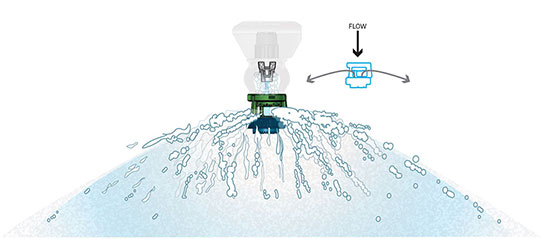
The Wide Spray Bubble provides total coverage for 30” to 60” spacing. It produces a wide gentle aerated pattern suitable for most crops and soils.

The LDN UP3 Bubbler Pad gently deposits water onto the soil surface in a bubbling stream. This aerated cascading stream resists the effects of wind and evaporation.
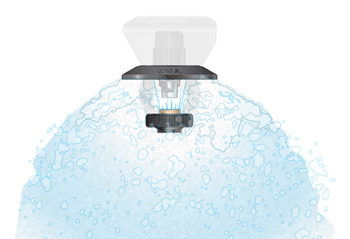
The LDN Shroud is used in conjunction with a bubble insert. Farmers can choose either a beige bubble pad insert or another LEPA insert that produces a different pattern opposite a variety of deflectors based on their soil type and crop. The Shroud deflects the water from the bubble insert down in a gentle dome-shaped pattern providing complete coverage of the field. Due to its less concentrated distribution pattern, the Shroud can be used on fields without furrows and is often used for germination as well as irrigation.
Senninger LEPA models are designed for easy conversion to spray irrigation when needed. All farmers need to do is twist and flip the deflector. Farmers can then use the spray side of the deflector pad for germination or LESA.
LEPA & LESA: HOW THEY COMPARE
Unlike LEPA, LESA systems use non-bubble applicators to irrigate –generally sprays. Both LEPA and LESA systems can operate at lower pressures ranging from 6 to 20 psi (0.41 to 1.38 bar) and typically require applicators be installed 8 to 18 inches (20 to 46 cm) above the ground. LEPA and LESA save water and energy compared to conventional irrigation and other pivot irrigation systems. The suitability of one method over another depends on the farmer’s needs.
Growers in water-scarce areas tend to rely more on LEPA due to its water savings benefits. Researchers from Texas A&M AgriLife found that “application efficiencies were in the range of 70 to 80% for LESA systems and greater than 90% for LEPA systems.” A UC Davis research shows LESA has “fewer problems with non-uniformity, crop germination, or with ponding and runoff […] and therefore can be more flexible with a wide variety of crops, row orientations, and tillage systems.”
LEPA and LESA are not universally applicable to all topography, soil types, crop planting, and farm management practices. The ideal maximum slope for LEPA systems is 1% to prevent runoff. LESA systems can operate with a maximum gradient of 3% for optimum results.
SUCCESS IN THE FIELD
Dyer, Nevada - Alfalfa
John Maurer of Triple D Ranch, in Dyer, Nevada USA currently manages 1,861 hectares of farmland and 52 center pivots. Thirty-seven of these pivots irrigate with LEPA sprinklers.
Triple D Ranch is located in the high valley of Dyer, Nevada where the weather is dry and windy, with little to no rainfall and very low humidity. Declining water tables, increasing pumping costs, as well as wind and evaporation loss led Maurer, the Farm Manager, to investigate ways to reduce water use and still retain successful yield levels.
After switching to LEPA Close Spacing, he produced an average of 21.5% more bales and 6.5% more tonnage during four cuttings on three pivots, with one pivot yielding 40 more bales. And he did this using less water.
Bakersfield, California - Potatoes, Carrots, Garlic, Onions & Watermelons
Bob Bender grows baby potatoes and rotates them with carrots and other small-seeded crops in Bakersfield, California. He set up his linear systems to use LESA Close Spacing irrigation with LDN UP3 sprinklers.
Bender's dealer recommended he try the LDN with the cotton plate, and he found it was ideal for germinating his small-seeded crops. LESA Close Spacing with LDN nozzles provided him the solution he was looking for: the finest droplet size and the most uniform application as possible. This solution helped them "succeed in getting the highest germination rates that they're seeing in carrots in the valley."
Tsitsikamma, South Africa - Pasture Crops
Danie Erasmus, from Winkelhaak Boerdery, a dairy farming operation in Tsitsikamma, South Africa, grows pasture crops for dairy cattle. “There are often challenges to get enough water into the soil profile, especially with the unpredictability of electrical power supply in South Africa due to load shedding.”, he explained.
Danie switched from running conventional sprinklers four days per week to using LEPA bubblers that provided the same yield with only three days per week of operation. “During the recent dry season, combined with high wind speed conditions, we noticed the increased efficiency of LESA packages versus conventional sprinklers. LESA/LEPA sprinklers give us the ability to manage our irrigation scheduling according to wind conditions, water, and electrical availability. We can achieve the same irrigation requirements in less time, which is a major advantage for our operation.”, he said.

Become an expert on LEPA & LESA technology by signing up for our FREE online training courses today. Learn the basics of LEPA and LESA irrigation and the best practices for installing these systems. Discover the many sprinkler options available today and how farmers are using these to save water, conserve energy and increase yields.
Most of our courses are certified by the Irrigation Association and worth one continuing education credit (CEU) toward your annual re-certification.

